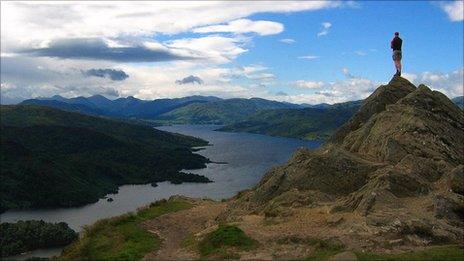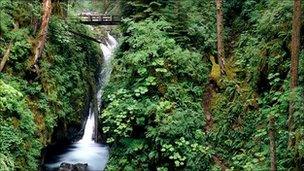The Scottish 'gold rush' for hydro power
- Published

Loch Lomond and the Trossachs National Park says it is encouraging the development of "appropriate" hydro schemes
Scotland is seeing a boom in small hydro schemes, with scores of streams and rivers earmarked for development. But why has this form of green energy suddenly become so popular?
There's a gold rush starting in the Scottish hills. But the rush is to find one of Scotland's most abundant resources - water - rather than a precious metal.
And specifically water that flows down steep enough slopes and ravines to allow it to generate an increasingly precious resource: energy.
One hydro specialist says it's the busiest his company has been for a "decade or more". Another consultant reports a three-fold increase in his work.
The Loch Lomond and the Trossachs National Park is encouraging the development of hydro power schemes within the park's boundaries.
And some communities are even planning to build their own local schemes.
So what has caused this sudden rush to hydro?
The primary reason is financial, says Matthew Crosher, who works for hydro engineers Gilbert Gilkes & Gordon Ltd.
"There's the new feed-in tariff that came in last year. The subsidy for producing green energy has been increased and it makes schemes more viable," he says.
And with such low interest rates - it is actually more effective to invest your capital in water than it is to leave it in your account.
"If you've got the money, you'll get more return on it by investing in hydro than you would on interest in a bank at the moment," says Mr Crosher.
"And any electricity you use from the scheme will be cheaper than you were paying before."

Run of the river hydro schemes can be made almost invisible
Added to that, hydro power can deliver much more predictable income than wind farms - and the infrastructure is likely to last longer with less maintenance costs.
Hydro specialists Gilkes are currently working on several schemes in the Loch Lomond National Park and the park's water resource manager is working to identify many more burns appropriate for development.
The national park's convener, Mike Cantlay, says he would always favour water over wind.
"In the park, water is so prevalent - there are 50-odd major rivers and obviously the loch system - that we need to focus on the water elements before we even think of the wind elements," he says.
"The power of Scotland's water, I think, is just amazing."
For a national park visited by millions of people a year who are primarily attracted to the scenery, there is also the benefit that hydro developments rarely attract the sort of fierce opposition that wind farms proposals often do.
Water to cash
The visual impact of "run of the river" schemes can be kept to a minimum. Two of the three elements required - the pipeline and turbine house - can be buried, and the intake at the top of the stream is often barely noticeable.
It is for this reason that some towns and villages are willing to build these schemes on their doorstep.
And then there's the income from the energy, which at a time when so many public grants are drying up, suddenly provides a new way of paying for projects that the council or government can no longer fund.
One such community is Callander, near Stirling, which hopes to build a scheme of up to 240KW on Ben Ledi, a hill a few miles north of the town.
It would be enough to power about 200 homes, but the electricity generated will be sold directly to the National Grid.
Frank Park, the chairman of the Callander hydro project, says that for an initial investment of about £700,000 the scheme should provide an income of £3m over 30 years.
"We've experienced difficulties finding funds for projects, and really this is giving us a bit of autonomy," he says.
"It'll enable us to choose our own projects - the ones we want to develop - and allow community groups to come to the development trust and say - I've got this idea."
The money could be used a variety of ways, from flood prevention to revamping the town's public toilets, says Mr Park.
But among the many proponents for hydro power, there are voices of opposition.
A project planned for the Aberfeldy Birks in Perthshire has been stalled after locals objected that it would have a negative impact on plant life and tourism.
Campaigners complained that the scheme would effectively throttle the stream when in spate - always a spectacular draw for tourists - and could affect rare mosses along the banks.
Concerns in other areas have focused on the effect on fish populations.
A study on the impact on tourism in Aberfeldy was inconclusive, but botanist Gordon Rothero - who consults for many hydro companies - says not enough work has been done to assess the long term effects on plants.
"We were very slow off the mark with this. We didn't see this coming," he says.
"What we would really love to know over a reasonably long term is what changes do actually happen when you stop water going down a river."
Energy scramble
Mr Rothero says there are plenty of streams suitable for hydro schemes, but hopes developers will stay out of the ravines that are home to "globally rare" plants.
"It's been a bit of a gold rush really because it's happened fairly quickly. All of a sudden we have a large number of applications for small-scale run of the river hydro schemes," he says.
As far as the Lomond National Park is concerned, Mr Cantlay says any scramble for hydro should be tempered with the park's duty to safeguard the landscape.
"The world is desperate to find new ways of finding energy, better ways of using natural resources. In the midst of all of that it's quite difficult to make sure that we're not making mistakes," he says.
"We might have a plan that only comes together in 30, 50 or 100 years but might be quite visionary in how Scotland makes best use of its water - and ensures that we don't damage the environment."
- Published16 December 2010